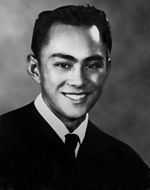Rodney J. T. Yano
| Rodney J. T. Yano | |
|---|---|
|
Rodney Yano | |
| Born |
December 13, 1943 Kealakekua, Kona district, Hawaii |
| Died |
January 1, 1969 (aged 25) near Bien Hao, Republic of Vietnam |
| Place of burial | National Memorial Cemetery of the Pacific, Honolulu, Hawaii |
| Allegiance | United States of America |
| Service/branch | United States Army |
| Years of service | 1963 - 1969 |
| Rank | Sergeant First Class |
| Unit | 11th Armored Cavalry Regiment |
| Battles/wars | Vietnam War |
| Awards |
Medal of Honor Air Medal Purple Heart |
Rodney James Takahashi Yano (Japanese surname: 矢野, December 13, 1943 – January 1, 1969) was a United States Army soldier and a recipient of the United States military's highest decoration—the Medal of Honor—for his actions in the Vietnam War.[1]
Early life
Yano was born in Hawaii. His grandparents were Japanese immigrant parents. Yano was a Sansei, which means that he was a third generation Japanese-American.[2]
Soldier
Yano joined the Army from Honolulu, Hawaii in 1963.[3] By January 1, 1969 was serving as a Sergeant First Class in the Air Cavalry Troop, 11th Armored Cavalry Regiment. On that day, near Bien Hoa in the Republic of Vietnam, Yano was acting as a helicopter crewmember on the aircraft piloted by John Bahnsen during combat action when a white phosphorus grenade exploded inside the aircraft. Despite being burned because he was covered in white phosphorus and having lost the use of one arm, Yano proceeded to throw the remaining ammunition off the helicopter as flaming fragments of the grenade were causing it to catch fire and detonate. His selfless actions were credited with saving the lives of the others on board the helicopter.
Yano, aged 25 at his death, was buried in the National Memorial Cemetery of the Pacific, Honolulu, Hawaii.
Medal of Honor citation
Sergeant First Class Yano's official Medal of Honor citation reads:
Sfc. Yano distinguished himself while serving with the Air Cavalry Troop. Sfc. Yano was performing the duties of crew chief aboard the troop's command-and-control helicopter during action against enemy forces entrenched in dense jungle. From an exposed position in the face of intense small arms and antiaircraft fire he delivered suppressive fire upon the enemy forces and marked their positions with smoke and white phosphorus grenades, thus enabling his troop commander to direct accurate and effective artillery fire against the hostile emplacements. A grenade, exploding prematurely, covered him with burning phosphorus, and left him severely wounded. Flaming fragments within the helicopter caused supplies and ammunition to detonate. Dense white smoke filled the aircraft, obscuring the pilot's vision and causing him to lose control. Although having the use of only 1 arm and being partially blinded by the initial explosion, Sfc. Yano completely disregarded his welfare and began hurling blazing ammunition from the helicopter. In so doing he inflicted additional wounds upon himself, yet he persisted until the danger was past. Sfc. Yano's indomitable courage and profound concern for his comrades averted loss of life and additional injury to the rest of the crew. By his conspicuous gallantry at the cost of his life, in the highest traditions of the military service, Sfc. Yano has reflected great credit on himself, his unit, and the U.S. Army.[1]
Namesake
Yano is the namesake of the USNS Yano (T-AKR-297), a Shughart class cargo ship. She is a 'roll-on roll-off' non-combat United States Navy designated a "Large, Medium-speed, roll-on/roll-off" (LMSR) ship.
Yano Fitness Center at Camp Zama, Japan, Sgt. Yano Library at Schofield Barracks, Hawaii and Yano Hall Helicopter Maintenance Facility at Fort Rucker, Alabama are named in his honor.
See also
References
- ↑ 1.0 1.1 US Army Center of Military History (CMH), "Medal of Honor Recipients, Vietnam (M-Z)"; retrieved 2012-12-31.
- ↑ "Big Island Salute," Rafu Shimpo (Los Angeles). July 12, 2012; retrieved 2012-12-31.
- ↑ "Yano, Rodney J T. (MOH), SFC" at TogetherWeServed.com; retrieved 2012-12-31.

